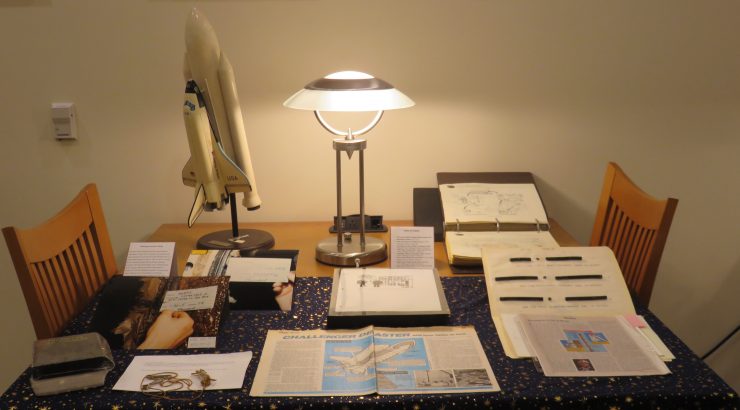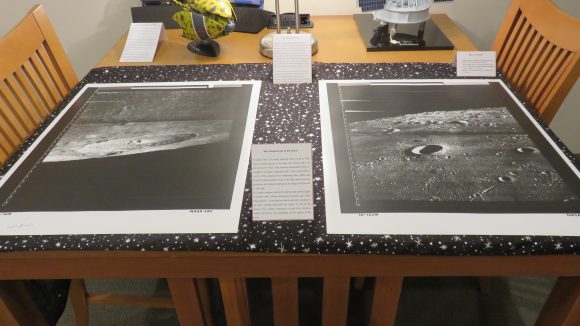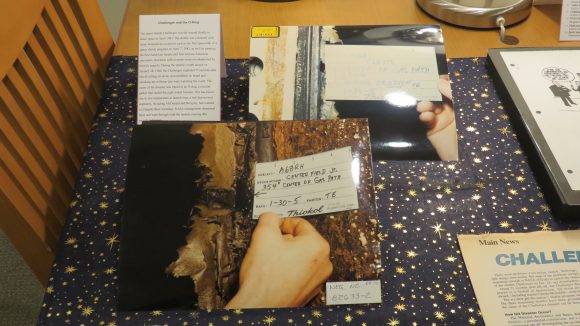Frank Mt. Pleasant Library of Special Collections & Archives Celebrates the 50th Anniversary of the Moon Landing Archival material from the space race, the Challenger disaster, and more
August 5, 2019
Just over two weeks ago, on July 20th, 2019, the world celebrated the 50th anniversary of Apollo 11’s landing on the moon. From re-airings of the original live television broadcast of the landing to special events at the Smithsonian Institute National Air and Space Museum in Washington, D.C., this exceptional achievement in the history of 20th century science was celebrated widely. The celebration even extended to the Frank Mt. Pleasant Library of Special Collections & Archives at the Leatherby Libraries, where a display of archival materials connected to the space race, Challenger disaster, and other space-related topics was curated by Circulation Assistant Wynter Salazar. Below are photographs of the materials displayed, along with text written by Wynter for the display.
“We choose to go to the moon”
President John F. Kennedy declared these words in 1962, which invoked urgency in the space race between the U.S. and the Soviet Union. This statement invigorated NASA to complete a seemingly impossible task. Seven years later on July 20, 1969, astronauts Neil Armstrong, Buzz Aldrin, and Michael Collins landed on the moon, with Aldrin and Armstrong leaving the first human footprints on its surface. But this was no easy task.
The Apollo program kicked off with the first crewed flights in October 1968, with the culmination of human space flight being Apollo 11, occurring less than a year later. Landing on the moon seemed impossible, but Apollo 11 proved this dream to be a reality, resulting in a total of six missions landed and twelve U.S. astronauts on the surface of the moon.
Challenger and the O-Ring
The space shuttle Challenger was the second shuttle to reach space in April 1983. The shuttle was connoted with many momentous occasions such as the first spacewalk of a space shuttle program on April 7, 1983, as well as carrying the first American female and first African American astronauts. But these achievements were overshadowed by horrific tragedy. During the shuttle’s tenth launch on January 28, 1986, the Challenger exploded 73 seconds after liftoff, killing all seven crew members on board and shocking the millions who were watching the event. The cause of the disaster was traced to an O-ring, a circular gasket that sealed the right rocket booster. This had failed due to low temperature at launch time, a risk that several engineers, including McDonald and Boisjoly, had warned of. Despite these warnings, NASA management dismissed them and went through with the launch, causing this tragedy to happen.
Space Travel and Pop Culture
The concept of space travel and space exploration has served to inspire humankind for centuries. Since Jules Verne’s 1865 novel From the Earth to the Moon, we can trace our ever-increasing preoccupation with “the future” through a lineage of films and literary works.
After the Apollo 11 moon landing, the popularity of mainstream Science Fiction media grew exponentially, as did public interest in spaceflight and contemporary astronautical science. The exhilaration of the space race and the exploration of our solar system echoed throughout the arts, as can be seen in the steady rise in popularity of many of our beloved science fiction staples such as 2001: A Space Odyssey, The Jetsons, Star Trek, Star Wars and Babylon 5. The Babylon 5 television series consisted of five seasons consisting of 22 episodes each. The show chronicled an epic story concerning a pivotal space station at the crossroads of a variety of galaxy-shaking events, including galactic war, political intrigue and civil unrest.
The Apollo 11 mission helped to capture an entire generation of story tellers, and as historian Margaret Weitekamp, curator of space memorabilia and science fiction objects at the National Air and Space Museum said, “Spaceflight, I think, is a rich backdrop for telling different kinds of stories.”
Items on Display
- Nimbus weather satellite, 1/8 scale model (NASA Space Program Demonstration Models)
- Lunar images (Stallworth lunar images collection)
- Vorlon Ambassador Shuttle production maquette (Copeland Babylon 5 Collection)
- Babylon 5 MicroMachines toys (Copeland Babylon 5 Collection)
- 1982 Space Shuttle Transportation System Press Information binder (2015-118)
- Field tested pieces of O-Ring (Boisjoly NASA Challenger Disaster Collection)
- “Zeroing In on the O Rings” newspaper article (Boisjoly NASA Challenger Disaster Collection)
- “After Due Consideration” comic strip (Boisjoly NASA Challenger Disaster Collection)
- Challenger Disaster newspaper article (Boisjoly NASA Challenger Disaster Collection)
- NASA Space Shuttle tile and tethers (NASA Space Program Excess Property collection)
- Field tested O Ring erosion photos (Boisjoly NASA Challenger Disaster Collection)
- Early Space Shuttle Stack (NASA Space Program Demonstration Models





